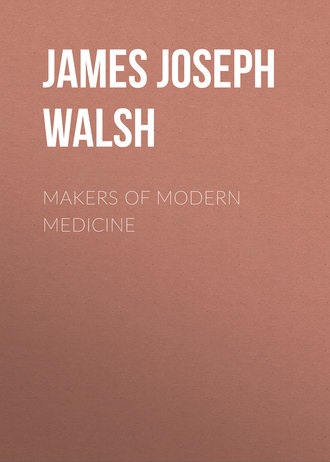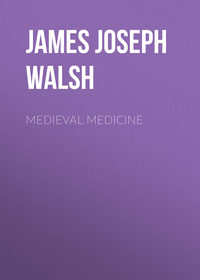 полная версия
полная версияMakers of Modern Medicine
Morgagni, in discussing the reason why the diaphragm should be excited into sympathetic reaction by the presence of an irritant in the nose, pointed out a fact that had been forgotten or the significance of which had not been appreciated. The membrane of the nose concerned in smell is supplied by the first pair of cranial nerves, the so-called olfactory nerves. Between this olfactory nerve and the nerve which supplies the diaphragm, the phrenic nerve, which is a cervical and not a cranial nerve, that is to say, comes from the central nervous system through the spinal cord in the neck and not directly from the brain, the older anatomists declared there was no connection. Morgagni pointed out that the mucous membrane of the nose is partly supplied also from the fifth pair of cranial nerves. From the fifth nerve, small branches of connection with the cervical nerves, as low even as the intercostal nerves, had been traced by Meckel. This shows the possibility of a nervous reflex; that is, of a communication of nerve impulses without the necessity for the intervention of the central nervous system.
This was the first direct tracing of distant reflex nervous action in human physiology. The problem of nervous reflexes was to remain obscure for more than a century later, until light was thrown upon it by the investigation of the French physiologist, Claude Bernard. Here, however, was the pregnant suggestion of the explanation of the seeming mystery. In subsequent cases Morgagni looked for the confirmation of his theory in this matter and found it. He pointed out that there was a relationship between the abdominal viscera and the olfactory mucous membrane of the nose. In one of his cases an epileptic seizure was always accompanied by a sense of discomfort in the upper abdominal region and a fetid odor. This odor was entirely subjective; that is, though extremely annoying to the patient it could not be noticed by any one else, even though the patient was close at hand and exhaled his breath at the moment of the observation.
This would seem to point to the fact that Morgagni suspected there were other connections between the special senses and important organs besides those which had been discovered by anatomists up to that time. As a matter of fact the so-called sympathetic nervous system does place all the organs of special sense in direct connection with the other important organs of the body. Morgagni's suspicions were to be confirmed by the discoveries made in this sympathetic system during the succeeding century.
Morgagni first of all seems to have realized what was the mechanism by which alcohol injures the human system. He pointed out that the excitation of the heart due to the action of alcohol was reflected in an overdistention of the arteries. This overdistention gradually led to degenerations in the arterial walls. The loss of elasticity thus induced brought on a disturbance of the circulation in the important organs of the body, and so gave rise to symptoms of wide-spread interference with organic functions.
Morgagni's studies in aneurism, that is, in the dilatation of bloodvessels, show how thoroughly he understood the mechanism of the formation of this serious pathological condition. He pointed out that the first noticeable disease change that occurs is a degeneration of the inner coat of the artery. This leads to the formation of furrows on the inner wall of the vessels and finally brings on weakness of the middle coat of the artery. He realized that the progress of these arterial changes is due to a large extent to blood pressure within the arteries. He felt, too, that blood pressure could be kept from being dangerously high by strict attention to diet limitation. If aneurisms are discovered in early stages the patient's life may well be prolonged by these simple measures. This idea contains the germ of the Tufnell treatment, which has been the most successful therapeutic measure for the treatment of aneurism in the nineteenth century.
The Italian anatomist's acumen led him to appreciate better than ever before in medical history the influence of the mind on the circulation. He pointed out that emotions have a powerful influence on the circulatory system in all its parts. How much the peripheral bloodvessels are affected can be seen in the tendency to blushing during certain forms of excitement, involving shame or embarrassment; on the contrary, pallor in anger, or indignation, or fright. He pointed out, too, that the heart is affected by such emotions and is sometimes strenuously excited and sometimes very much retarded. Morgagni understood that the influence of such emotions in especially excitable individuals leads to wear and tear on the bloodvessels and so to a shortening of lives. He thought of some aneurisms, even those affecting the large bloodvessels, might be caused by sudden intense emotions, and especially by violent efforts to suppress or conceal emotions. We know now, however, that these pathological conditions are due to human passions, but quite other than those which Morgagni had in mind.
It is interesting to note that comparative pathology–that is, the study of the diseases of animals as illustrating corresponding conditions in human beings–had already attracted the attention of the Bolognese school of medicine. Albertini, who had been a professor of Morgagni's, pointed out that aneurisms are rarely found in animals, because brutes were not subject to emotions as are human beings. Morgagni made still further observations in this line to confirm his own conclusions in the matter. For a time in his earlier life he devoted himself to the study of fishes, because they seemed to promise to throw light on certain problems in human anatomy and pathology.
How closely he studied pathological changes in tissues can be gathered from the fact that his observations led him to point out that aneurism of the aorta occurs most frequently at that part of the curvature of the aorta against which blood is constantly projected by the heart. The realization of the importance of this mechanical factor in the production of aneurism is one of the first successful results of carefully applied observation and knowledge of physical laws in the causation of changes in the tissues as opposed to elaborate theories with very little foundation in fact.
Variations in the pulse attracted his attention, and he was among the first to point out that the occurrence of flatulency is liable to cause disturbance of the heart's action and to bring on noticeable cardiac palpitation in the absence of any organic affection of the heart itself. Morgagni also pointed out that intermittence of the pulse may be due to nervous conditions. He showed that severe mental shock or trying emotions may cause irregularity of the heart's action and pulse intermittency. Some of his observations in this matter show an intuition with regard to the nerve supply of the heart that is quite beyond the anatomy of his time, and seems to indicate that he suspected the existence and function of the sympathetic system and also the existence of a special nerve supply to the small arteries.
Perhaps Morgagni's most penetrating evidence of insight in pathology and its relations to clinical medicine is with regard to tuberculosis. Over a century and a half ago he insisted on its contagiousness. He refused to make autopsies on patients who had died of tuberculosis, and his position in the matter was undoubtedly of the greatest service in directing the attention of his contemporaries, and especially those closely in contact with him, to the important question of intimate association with tuberculous patients as a potent factor in the acquirement of the disease, more potent even than heredity which then occupied all men's minds on this subject.
It might be deemed that this advanced position of Morgagni was due rather to intuitive abhorrence of the disease than to the conviction of actual observation, and that his conclusions were the result more of prejudice than of real knowledge. Any such opinion, however, is absolutely contradicted by the fact that he knew and understood better than any one of his generation the pathology of consumption. He pointed out at a time when any chronic affection of the lungs was liable to be considered consumption that there are a number of forms of chronic bronchitis that are not due to pthisis pulmonalis, but to other slow-running conditions within the lungs.
He anticipated very completely the present position of surgery with regard to the treatment of cancer. He advised the operative removal of these malignant tumors whenever possible. As Benjamin Ward Richardson points out, this advice was given evidently not with the idea that the disease could be always thus completely cured, but because early operation gave speediest relief of annoying symptoms and assured the greatest prolongation of life. Many other methods of removal of cancerous growths were suggested in Morgagni's time, as in our own, and many false promises made and false hopes raised by their advocates. He pointed out that the quickest, the safest, the surest and in the end, for the patient, the easiest method of removal is by the knife in the hands of the bold and skilful surgeon. After a century and a half of vauntedly great advance, especially in surgery, we are practically in the same position as when Morgagni's advice was penned, and his opinion remains practically as valuable to-day as then.
In another important point of medicine Morgagni seems to have anticipated the opinion of our own time. It was the custom to practise venesection very freely. On one or two occasions in his own lifetime Morgagni fell ill and venesection was recommended. His biographer says that he constantly refused this method of treatment, adding very naively, "and he who had often cured others by venesection would never allow this remedy to be used upon himself because, as I believe, he had a natural abhorrence to it."
It was an index of thoroughgoing independence of thought in those days to stand out, even for personal reasons, against the overwhelming tradition in favor of blood-letting. But Morgagni had well-grounded doubts as to the remedial efficacy of abstraction of blood, and at least avoided it in his own case.
Besides his skill in practical and theoretic medicine, Morgagni was a man of cultivated taste in art, and he was conversant not only with the literature of his own language, but also of French, Latin and Greek. He was always welcomed in the literary circles of the cities of Northern Italy, and counted among his friends many of the great writers of the time. His success in winning the friendship of rulers was especially noteworthy, and had not a little influence for the advantage of education and science. The patricians of Venice were proud to consider him as a personal friend, and to the Venetian Senate he owed his professorship at Padua. The King of Sardinia, Emanuel III, looked upon him as an intimate acquaintance. All the Popes, five in number, of the second half of his life were on terms of personal intimacy with him, and his advice was asked on many important questions with regard to educational matters in his own day.
Some of these Popes are among the most influential pontiffs that ever occupied the Roman See. The great Benedict XIV, himself a native of Bologna and an intimate friend of the scientist, in his classic work "De Beatificatione Servorum Dei" mentions Morgagni in terms of special commendation. His scarcely less famous successor, Clement XIII, had often consulted Morgagni professionally at Padua before his elevation to the See of Rome. After his election as Pope he assures Morgagni of his continued esteem and friendship, and asks him to consider the Vatican always open to him on his visits to Rome. In an extant letter Clement praises his wisdom, his culture, his courtesy, his charity to God and men, and holds him up as an example to others, since with all his good qualities he had not aroused the enmity or envy of those around him.
Morgagni's life must have been in many ways ideally happy. Rewards for his scientific success began early in life, even before his professorship, and continued all during his long career. The Royal Society of England elected him a fellow in 1724; the Academy of Sciences of Paris made him a member in 1731. In 1735 the Imperial Academy of St. Petersburg conferred a like honor upon him. In 1754 the Academy of Berlin elected him to honorary membership.
His English biographer, Dr. William Cook, says quaintly that all the learned and great who came into his neighborhood did not depart without a visit to Morgagni. He was in correspondence with most of the great men of his time, and the terms of intimate relationship that this correspondence reveals are the best evidence of the estimation in which Morgagni was held, especially by the prominent scientists of his time. Among them were such men as Ruysch, Boerhaave, Sir Richard Mead, Haller and Meckel. This wide acquaintanceship of itself was a great distinction at a time when the means of communication were so much more limited than at present.
It is gratifying to think that Morgagni must have been enviably content in his private life, though, as usually happens when this is the case, very little is said explicitly on this subject. His untiring labor deserved the compensation of a loving domestic circle. During his retirement at Forli, after his graduation from the university and when, from overwork, his health failed him for a time, he married the descendant of a noble family of the town, Paola Vergieri by name, a companion for him who, biographers declare, could not have been surpassed in judgment or in affection. They had a family of fifteen children, eight of whom survived their father though he lived to the ripe age of eighty-seven years. There were three sons, one of whom died in childhood; another became a Jesuit and taught in the famous Jesuit school at Bologna whose magnificent building has now become the municipal museum, the Accademia delle Belle Arte. The third followed his father's profession, married and settled in Bologna, but died before his father, who assumed the care of his grandchildren. All Morgagni's daughters who grew up to womanhood, eight in number, became nuns in various religious orders.
The spirit of science had not disturbed the development of a homely simple faith in the family. The great Father of Pathology, far from being disturbed by the unselfish self-sacrifice of so many of his children, bore it not only with equanimity but even rejoiced at it. His relations to his children were ever most tender. After the suppression of the Jesuits, his son, who had been a member of the order, worked at science with his father at the University of Bologna and not without distinction.
The estimation in which Morgagni was held by his contemporaries can be judged from the fact that twice when invading armies had entered the Emilia and laid siege to Bologna, their commanders, as in old Greek history did the Grecian generals with regard to Pindar and Archimedes, gave strict orders that special care was to be taken that no harm come to Morgagni, and that his work was not to be hampered. Having lived his long life amidst the reverent respect of all who knew him, he died full of day and honors.
Succeeding generations have not been backward in acknowledging Morgagni's merits. I have already spoken of Virchow's tribute to his greatness. The Italians have long considered him as one of their most brilliant names in medicine. One of the best known of the representative Italian medical journals is Il Morgagni, published at Milan. To its pages the foreigner seeking to know the progress of Italian medicine turns almost as the first resort. Il Morgagni was founded some fifty years ago, and continues to uphold its reputation as one of the world-known medical periodicals.
The great medical scientist whose work was to prove the foundation of modern pathology, and thus be the source of more blessings to mankind than ever even he dreamed of, remained in the midst of the reverence and gratitude of his generation, one of those beautifully simple characters whom all the world delights to honor. As a teacher he was the idol of his students. No great scientist who came to Italy felt that his journey had been quite complete unless he had had the privilege of an interview with Morgagni. This friend of Popes and of many of the European rulers was the happy father of a houseful of members of religious orders, and considered himself blest that so many of them had chosen the better part. He was himself all during his long life the ardent seeker after truth, who did well the work that came to his hand and followed his conscience in sincere simplicity of heart and reaped his personal reward in the peace that is beyond understanding to those who have not the gift of faith to appreciate the things that are beyond the domain of sense.
AUENBRUGGER, THE INVENTOR OF PHYSICAL DIAGNOSIS
While medicine is your vocation, or calling, see to it that you have also an avocation–some intellectual pastime which may serve to keep you in touch with the world of art, of science, or of letters. Begin at once the cultivation of some interest other than the purely professional. The difficulty is in a selection and the choice will be different according to your tastes and training.
--Osler, Aequanimitas and other Addresses.At the present time the most interesting development in medicine is the gradual reduction of the death rate from tuberculosis. This is entirely due to the fact that the disease can now be recognized very early in its course, and that, as a consequence, the treatment may be begun before serious damage has been inflicted on the lungs. Under the circumstances, the disease formerly supposed incurable has become according to all the best modern authorities one of the most tractable of infectious diseases. In their recent lectures in Philadelphia, before the Phipps Institute for the Prevention and Cure of Consumption, such distinguished medical authorities as Dr. Trudeau, of Saranac; Professor Osler, of Johns Hopkins, and Professor G. Simms Woodhead, of Cambridge, England, insist on the absolute curability of tuberculosis when it is taken in time. Professor Woodhead particularly asserts that there has been entirely too much pessimism in this matter, even among physicians.
This present confidence with regard to the successful treatment of pulmonary consumption is due to the fact that the diagnosis can be made early. The glory of this early recognition depends entirely on two men–Auenbrugger, of Vienna, and Laennec, of Paris. To Auenbrugger, whose work was done nearly half a century before that of Laennec, must be given the credit of having first approached the problem of differentiating diseases of the lungs from one another by methods which were so objectively practical that every practitioner of medicine could, after having become expert in their employment, use them with absolute confidence in his diagnosis.
Modern medical science and practice acknowledges very gratefully its deep obligations to what is known as the Vienna school of medicine. It is not a little surprising to find that it was the practical side of medicine particularly which was developed at Vienna, since the inhabitants of the Austrian capital, while supposed to have artistic tastes far above the average, are usually considered to be among the most impractical people in Europe. For over one hundred and fifty years, however, the medical department of the University of Vienna has always ranked among the first in the world. Many of the Viennese professors of medicine have been acknowledged as the greatest teachers of their time. Beginning with Van Swieten and De Haen during the second half of the eighteenth century, the medical department of the University of Vienna has scarcely ever been without at least one of the leading lights of medicine in Europe. Wunderlich, Rokitansky and Skoda were, in the middle of the nineteenth century, the greatest medical men of their time. Hebra, Billroth and Nothnagel worthily continued the tradition of medical greatness in the Austrian capital. Even at the present time, notwithstanding the great advance in medicine and medical teaching that has come over all Europe, it is generally conceded that the best place in the world to study clinical medicine–that is, to study illness at the bedside of the patient–is the famous Allgemeines Krankenhaus, the General Hospital of Vienna.
The clinical teaching of medicine developed much later in the history of medical education than might naturally have been expected. There is a tradition of bedside instruction in medicine in old Grecian times at the various shrines of AEsculapius, but this is not well authenticated. Early in the sixteenth century came the modern birth of clinical medical instruction at St. Francis's Hospital, in Padua, in connection with the University there, which in every line did so much for modern medicine. The first clinic that attracted widespread attention, however, did not come until Boerhaave's time, at the end of the seventeenth and the beginning of the eighteenth century. The bedside instruction in medicine by this distinguished master drew hosts of students to the hitherto comparatively unimportant University of Leyden, in Holland. Two rulers–just the two who, to modern minds, would perhaps appear least likely to do so–at once recognized the immense practical value of this innovation in medical teaching and immediately set about securing its benefits for their people. Pope Benedict XIII and the Empress of Austria put themselves in communication with Boerhaave, and the Pope was the first to avail himself of the advice in the matter which the great Dutch master gave. The Roman clinic became, in the first half of the eighteenth century, under the direction of the distinguished Lancisi, one of the best known in Europe.
The Austrian Empress, Maria Theresa, interested in everything that could prove to be for the benefit of her people, invited the distinguished pupil of Boerhaave, Van Swieten, to become her family physician, and encouraged him in the foundation of a clinical medical school at Vienna. Van Swieten soon came to occupy a very prominent place at Court. When he was invited from Holland, on the recommendation of the sister of the Empress, there was no heir to the Austrian crown, though one had been anxiously looked for for several years. Heirs to the number of sixteen in all blessed the imperial family in the next twenty-five years, and Van Swieten became the confidential adviser of the reigning monarchs in polity as well as in medicine. Accordingly, when he suggested the invitation of De Haen, who had also been a pupil of Boerhaave, the suggestion was promptly accepted, and the Leyden colleagues became the founders of the Old Vienna School of Medicine, as it is called. They established the tradition of bedside teaching, of actual practical experience in the treatment of patients, and of the collection of detailed information of every feature of cases that could possibly be helpful for diagnosis. They also established the custom of demonstrations on pathological material with confrontation of the diagnostic conclusions during life and the findings of the postmortem examination in fatal cases, which, down to our own day, makes Vienna an ideal place for serious post-graduate work in clinical medicine.
It was not long after the establishment of the clinic on these broad lines at Vienna before the first important fruit of the new teaching method was to be gathered. Curiously enough, however, this initial advance in practical medicine did not come from one of the distinguished heads of the clinic, but from a comparatively young man of no previous reputation. The greatest discovery ever made at Vienna is due to Auenbrugger, an unassuming practitioner of medicine, who came from the Austrian province of Styria, or, as it is called in German, the Steiermark, about the middle of the eighteenth century. He was the son of a small hotel keeper of Gratz, and, after making his medical studies in Vienna, he remained at the capital for some years, doing hospital work.
While thus engaged, the young Styrian, who attracted very little attention except for his affability, and who made no pretension to special knowledge or genius in observation, laid the first stone in the structure of modern exact diagnosis of pulmonary disease, and cleared up many of the obscurities in which all affections of the chest had been shrouded before his time. Having accomplished this noteworthy achievement before he was forty years of age, Auenbrugger then quietly settled down to be an ordinary medical practitioner in the Austrian capital, with a special reputation for his knowledge of chest diseases, and for kindly ways that gave him as much interest in his poor patients as in those that could afford to pay handsomely for his services.











